PREPARATION
The activity should be carried out in groups of two to four. This helps distribute the work (measuring, documenting the data, plotting, etc.).
Remember that the second activity (contour map) is particularly time consuming. So, select in advance map-making exercises that fit your time frame.
Important! The worksheets have to be adjusted to fit the landscape model and the measuring grid envisaged for this activity.
Each group will receive one box with the hidden landscape model inside. Prepare as many work-sheets as there are pupils in the room. The sheets contain background information and a table with empty rows and columns consistent with the grid of measuring positions on the lid of the box. In this example with 12 × 9 points, it looks like an empty version of Table 2.
Each group gets a measuring device (ruler, tape measure) and a skewer.
INTRODUCTION
Introduce the topic of radar altitude measurements with a discussion of the following questions.
Q: How would you measure distances and heights?
A: They will definitely mention rulers, yardsticks, etc.
Q: How would you measure the distance to thunderstorms?
A: When they see lightning, they should start counting. For every 3 seconds, the distance would be 1 km.
Q: Why does this technique work?
A: The speed of sound is considerably lower than the speed of light. Thus, time required for sound to travel is a measure of distance.
Q: Can you also define distances based on the speed of light? What are the units of distance be-tween stars?
A: A lightyear is the distance light propagates within a year. So, if one can measure how long light takes to travel from a source to a receiver, one can infer the distance.
Q: The problem is that clouds can block light. Are there other kinds of light/electromagnetic waves that could be used instead? If they need assistance, mention systems that measure the distances between ships and boats or to airplanes.
A: Radar
Q: How do radar stations work?
A: Signals are emitted, reflected off the target and received again. The signal travel time is used to calculate the distance.
Q: Can you imagine a technology that permits the measurement of the height of the Earth’s surface at various points?
A: Radar technology combined with low-orbiting satellites should be able to do this.
ACTIVITY 1: PAINTING BY NUMBERS -CONSTRUCTING A COLOUR-CODED ALTITUDE MAP (Mandatory)
The students are provided a box containing a landscape model that they cannot see. In addition, they have a skewer, a length measuring device and the worksheet to note down the measurements.
Figure 15: Schematic view of a landscape model inside a box with a measuring grid on top (Credit: O. Fischer, HdA).
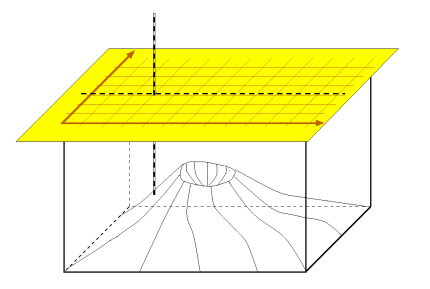
The students use the skewer as a measuring rod. They insert it in each hole or through each grid position and slide it down gently until it hits solid material (Figure 15). If the surface of the model is deformable, tell the students not to use too much force. It is important that the skewer remains perpendicular to the plane of the lid at all times. Then, they measure the length of the protruding end of the skewer and note down the value in the table cell that represents that position on the box. A precision of 5 mm should be sufficient.
After covering all grid points, they will have filled the table completely. Table 2 shows the result for the current example.
Let the students analyse the result: - What are the minimum and maximum values? - Where is the peak?
Table 2: Table of altitude measurements used in this example.
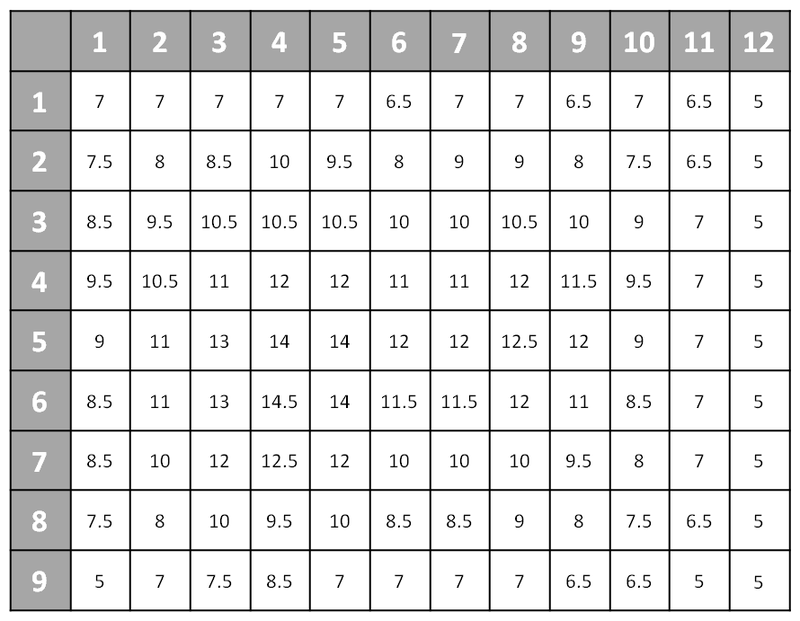
Ask the students if they can easily recognise the topography of the probed item. They will probably deny this. It would be quite difficult to imagine.
Show them the example of the colour-coded ice surface map in Figure 6 or any other topographical map, e.g. in an atlas. Ask the students if they can identify different altitudes. They will probably realise that colour coding is a viable approach to visualise the measurement.
Discuss with the whole group the number of reasonable steps for the colour coding of their own map. Usually, a colour table starting from violet for low numbers through different shades of blue, green, yellow, orange and red is suitable for assigning colours to number intervals.
Let the students now construct a colour-coded altitude map. They can directly colour the table that has the measurements they obtained.
In the example used as template for this activity, the resulting 12 × 9 table contains numbers at 0.5 cm resolution, and this accuracy should be sufficient. Table 2 represents the results of the measurements obtained with the landscape model used in this example. The outcome naturally depends on the model prepared for this activity.
Converting this table into a colour-coded altitude map results in Figure 16.
Figure 16: Colour-coded altitude map derived from the measurements documented in Table 2.
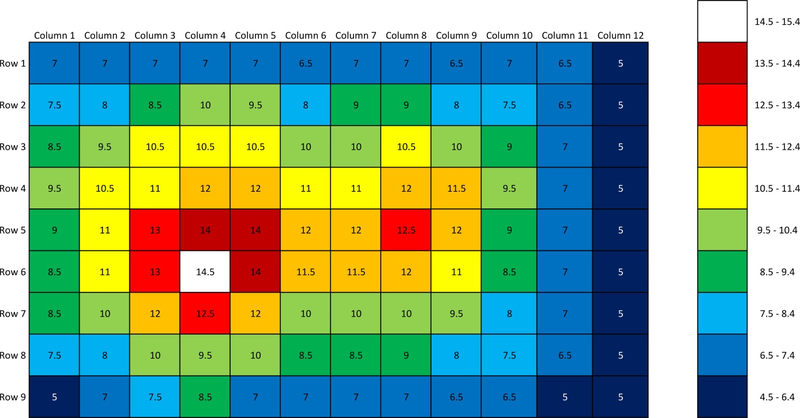
After finalising the map, discuss with the students the probable shape of the models they probed. Let them open the box to compare the hidden structure with their expectations. Did they guess what the prominent features of the model were from the map?
In this example (Figure 16), the two peaks of different heights and the ridge between them are clearly visible.
ACTIVITY 2: CONSTRUCTING A CONTOUR LINE MAP (for advanced students only, can be skipped to save time)
This activity takes quite a long time. If the teacher decides to go through with it, he/she should start with one or a few contour levels to demonstrate the concept. The rest can be left for homework, if required.
Tell the students that they will now learn a different way of constructing maps.
Q: Is the resolution of the map constructed during activity 1 adequate to identify small-scale changes in the height of the landscape model?
A: No, it is not.
Q: Could there be a way to infer the changes in altitude between the positions of the measuring grid? Remind them that no measurement is ideal. There are no infinitely resolved measuring grids. So, how do cartographers produce maps from such information?
A: Within certain assumptions, the altitudes between the grid positions can be derived, e.g. with suitable calculations.
Q: Show them a topographical map with contour lines, e.g. Figure 7. What do the contour lines rep-resent?
A: They are lines of equal height.
Q: How is a mountain peak represented by contour lines?
A: Peaks are identified by a series of nested closed lines.
Q: How is it possible to identify such lines of equal height? Has every point on such a line been measured? Remind them of the interpolation they have studied before.
A: Most of the data points must have been inferred from isolated, discrete measurements.
The map will be constructed according to the instructions in the background information, which the students will also receive with the worksheet.
Hand out the rulers, calculators and graph paper for plotting.
Let the students transfer the measuring grid onto the graph paper as shown in sketch a of Figure 12.
Important: Remind them that each grid point corresponds to a cell in the table of measured values. Therefore, there should be as many intersections as there are cells in the corresponding table.
Let them decide on the number and values of the interpolated contour lines. Perhaps, they will choose the same sample as the one used in activity 1. Let them begin with the largest numbers so that they cover the peaks of the landscape model.
With the equations mentioned in the background information, the students calculate the positions of the interpolated values and add them to their plot. Remind them not to interpolate diagonally. For each value, they should connect the points smoothly.
Figure 17: Contour map of altitudes increasing in steps of one constructed form the values in Table 2.

For the example used here, the final result is given in Figure 17.
Q: Compare this (part of the) map with the result from activity 1. What are the similarities and differences?
A: The features should be visible more easily. The contour map appears to have a better resolution than the colour-coded map.
ACTIVITY 3: CONSTRUCT A 3D SURFACE MAP WITH MICROSOFT EXCEL
Provide the working groups with PCs equipped with MS Excel. This activity only works with software version 2010 or later. Only they can produce surface plots. If the teacher chooses to use different spreadsheet software, it is important that it also can produce surface maps.
Q: What other tools can you imagine could produce such maps? What do you think professional cartographers use?
A: Computers, of course.
Tell them that with this activity, they will actually do what cartographers do.
Let the students transfer the table of measured values into a table in Excel (Figure 18).
Figure 18: Excel table of measured values.

The students will work on their own, equipped only with the instructions provided in the worksheet. In order to plot the table as a surface plot, the students highlight the entire table including row and column labels with the mouse and then select Insert *Other charts *Surface (first icon).
Figure 19: The surface plot can be produced via Insert *Other Charts*.
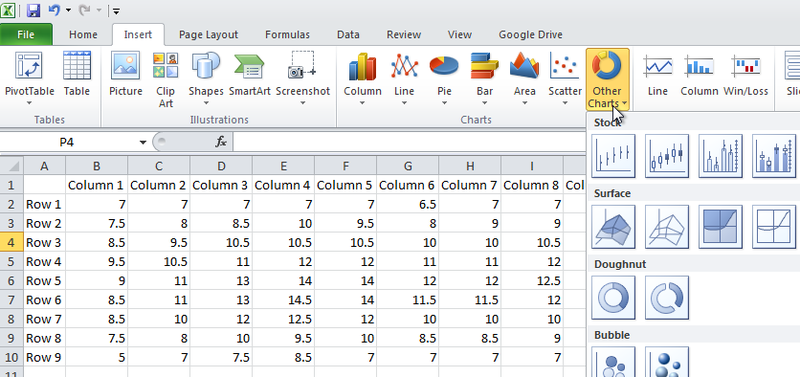
A new window appears, containing a surface plot of the altitude measurements. This is already a good representation of the hidden landscape model. However, the scaling and the colour coding are initially arbitrary and need to be adjusted.
To modify the scaling, first click on the graph window to activate it. Then click on the tick values next to the vertical axis. A grey frame will appear. Then double-click, and a new window pops up (Figure 20). Change the options of ‘Minimum’, ‘Maximum’ and ‘Major unit’ from ‘Auto’ to ‘Fixed’. Then enter the minimum and maximum integer values from the measurement. In this example, these are 5 and 15. ‘Major unit’ indicates the step size for the scaling and the subsequent colour coding, which is 1 in this example.
Figure 20: Axis options window of MS Excel.
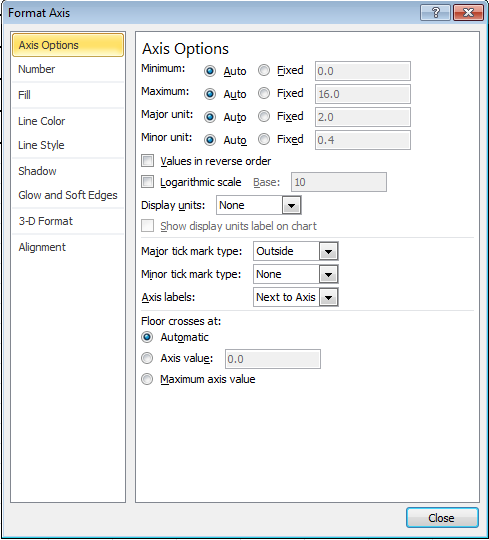
To change the colour coding, click on the legend. Again, a grey frame appears. Then select the colour to be changed by clicking with the left mouse button. Then right-click and a small pop-up window appears that permits colour changes (Figure 21). Select the one that indicates ‘Shape fill’, i.e. the bucket. From the panel, any colour can be chosen. Do this for all entries of the legend.
Figure 21: The colour coding can be adjusted via the legend.
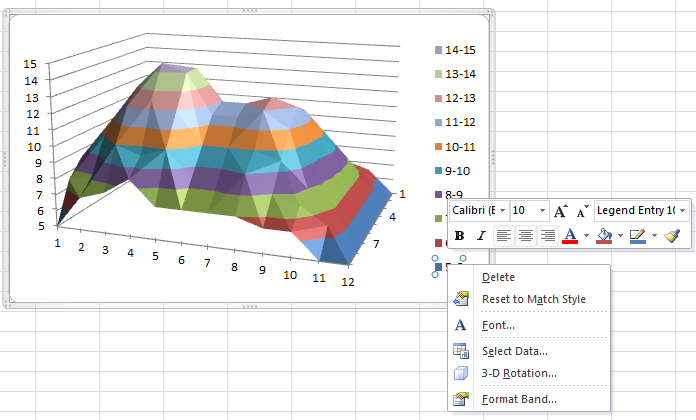
Note that the order of the rows initially displayed in the plot is from bottom to top, which differs from the input table. The order can be changed by double-clicking on the row axis and selecting Series in reverse order in the new window (Figure 22).
Figure 22: Dialogue window of MS Excel to change the settings of an axis. The axis representing the rows of the input table should be reversed.

Adjusting the viewing angles on the plot can be achieved by right-clicking on the plot and selecting 3-D Rotation. The new window enables modification of the three angles of orientation (Figure 23).
Figure 23: Options for rotating the surface map along three angles in space.
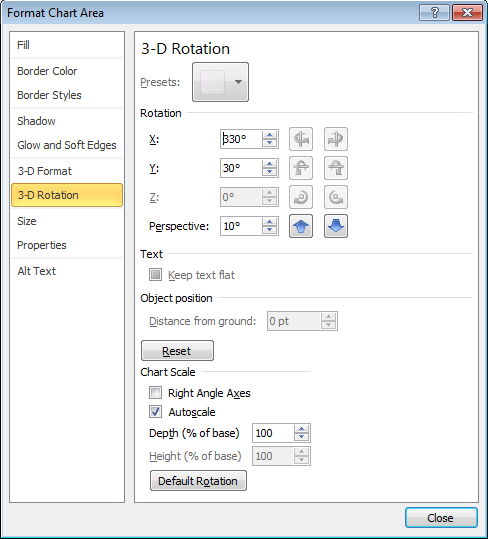
The students will produce two versions that show the data from different viewing angles. One should be right from the top and one should be from an angle that well represents the landscape model (Figure 24).
Figure 24: Surface plots of the altitude measurements used in the example.
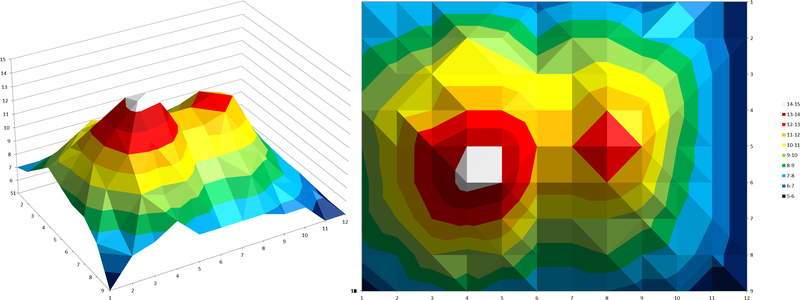
Compare the results with the ones from the other activities.
Let the students discuss the different techniques used to construct a map. How well is the real structure represented? Was the spatial sampling of the measurement sufficient?
CONCLUSION
Discuss the advantages and applications of satellite radar altimetry.
Q: Map services like Google Earth have altitude information stored for each map position. How was that obtained?
A: Via satellites
Q: Why have satellites been used for this? What is their advantage over on-ground measurements?
A: Satellite measurements are faster, more consistent and have wider and denser coverage.
Q: Can you imagine particular applications of radar altitude measurements taken from space?
A: Possible answers are - ice shield monitoring - flood or disaster management - plate tectonics and mountain range monitoring - monitoring water level rise and climate change































